State of Student Aid in Texas – 2019
Section 3: Profile of Texas College Students
Undergraduate Enrollment by Location and Sector (Fall 2016)
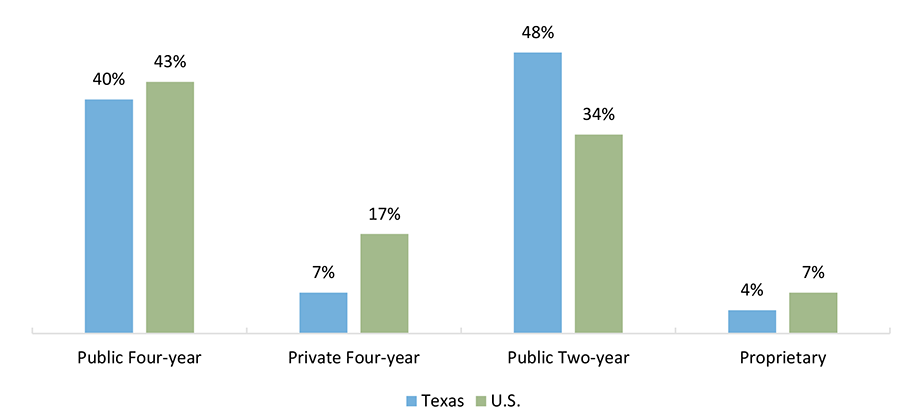
Almost half Texas undergraduates attended public two-year institutions in the fall of 2016, far higher than the percentage of undergraduates nationwide in that sector. Texas undergraduates were less likely to be enrolled at private four-year or proprietary institutions compared to undergraduates nationwide, and about as likely to be enrolled at public four-year institutions.
While its relative low cost helps create access to postsecondary education, students who enroll at public two-year institutions are more likely to attend part-time compared to students enrolled in other sectors. Part-time students are at a greater risk of dropping out compared to those attending full-time (see the next page), which is one of the factors that makes Texas undergraduates generally riskier than U.S. undergraduates.
Sources: U.S. Department of Education, National Center for Education Statistics, Integrated Postsecondary Education Data System (IPEDS) 2016 (http://nces.ed.gov/ipeds/).
Enrollment Intensity of Undergraduates in Texas and the U.S. (Fall 2016)
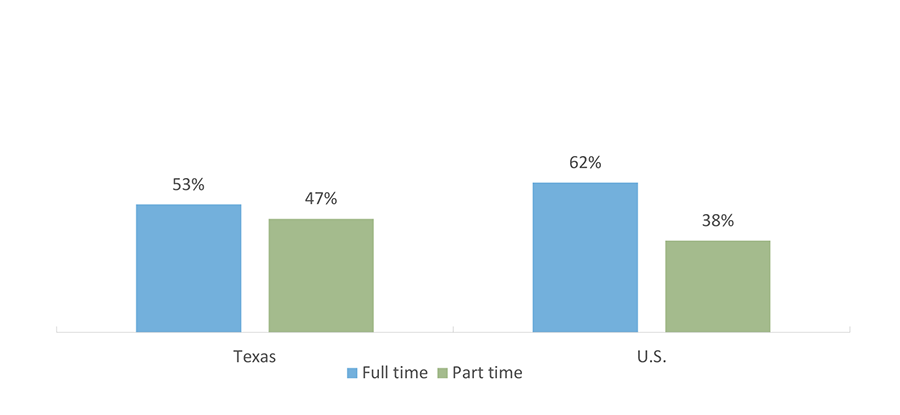
Enrollment Intensity of Undergraduates in Texas by School Sector (Fall 2016)
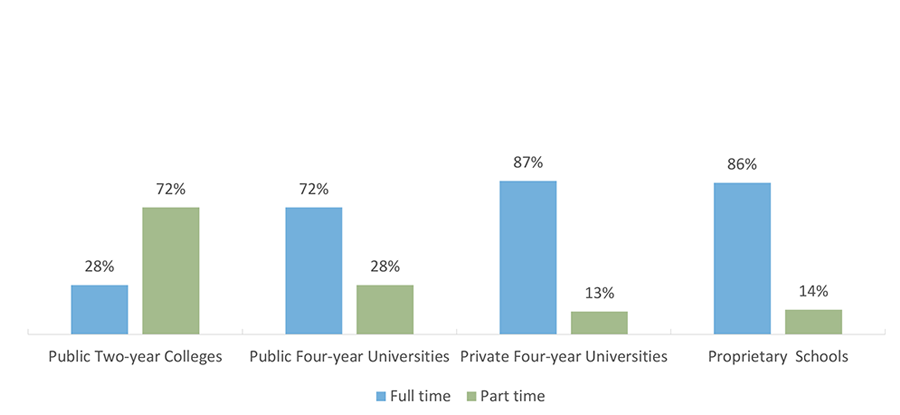
Part-time enrollment is more common in Texas than in the nation as a whole. As of fall 2016 about 53 percent of undergraduates in Texas were classified as full-time students. Full-time attendance is most common at private four-year universities, followed closely by proprietary colleges, then public four-year universities. At public two-year colleges, the largest sector by enrollments, less than a third of students attend full-time. Reasons for part-time enrollment vary but may pertain to financial concerns, like having limited funds for school expenses, trying to avoid student loans, or working more to provide for oneself and/or family. For several reasons, students who attend part-time are more likely to drop out of school.
Note: Institutions report their enrollment data to the Department of Education. The data are compiled but not de-duplicated at a student level, therefore some students may be concurrently enrolled at multiple institutions which may increase the proportion of students enrolled part-time.
Sources: U.S. Department of Education, National Center for Education Statistics, Integrated Postsecondary Education Data System (IPEDS) 2016 (http://nces.ed.gov/ipeds/); Fall 2015: Texas Higher Education Coordinating Board (THECB) 2016 higher Education Almanac Institutional Comparison Sheets (http://www.thecb.state.tx.us/index.cfm?objectid=A44B548A-E50C-8417-E09BF83FC11EA1EF).
Undergraduates by Classification and Sector (Fall 2017)
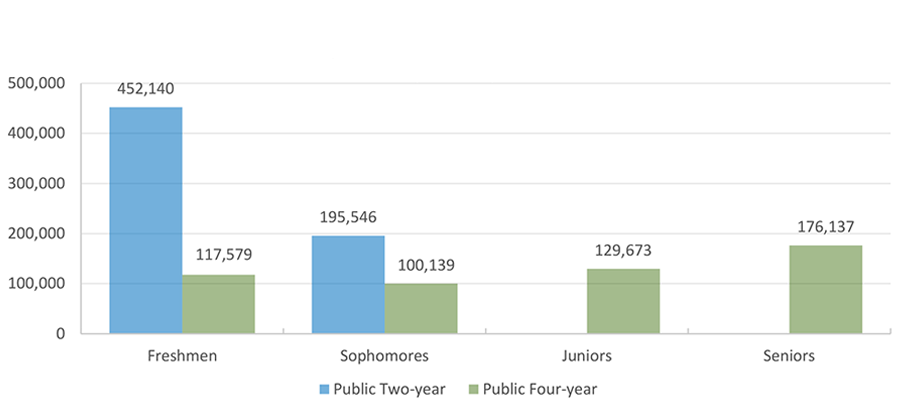
Texas Undergraduates by Race/Ethnicity and Sector (Fall 2016)
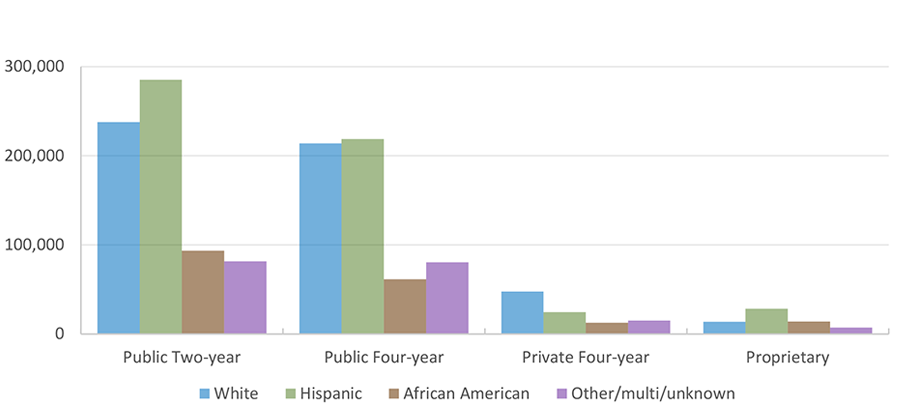
Across all races/ethnicities, the number of undergraduates at public two-year institutions in Texas exceeds the number at public four-year institutions and far exceeds the number at private institutions. In fact, 79 percent of all freshmen attending Texas public institutions of higher education in fall 2017 were enrolled at two-year colleges, and only 21 percent were enrolled at four-year universities.
Texas colleges and universities are exceptionally diverse. White students represent about a third or less at three of the sectors and just under half of students in the private four-year sector.
Sources: Enrollment by classification: Texas Higher Education Coordinating Board (THECB), Texas Higher Education Data, Accountability System Interactive Reports, Enrollment Statewide by Institution Type and Classification (http://www.txhigheredaccountability.org/AcctPublic/InteractiveReport/Accountability). Enrollment by race (fall 2016): U.S. Department of Education, National Center for Education Statistics, Integrated Postsecondary Education Data System (IPEDS) 2016 (http://nces.ed.gov/ipeds/).
Age of Undergraduates in Texas and the U.S. (Fall 2015)
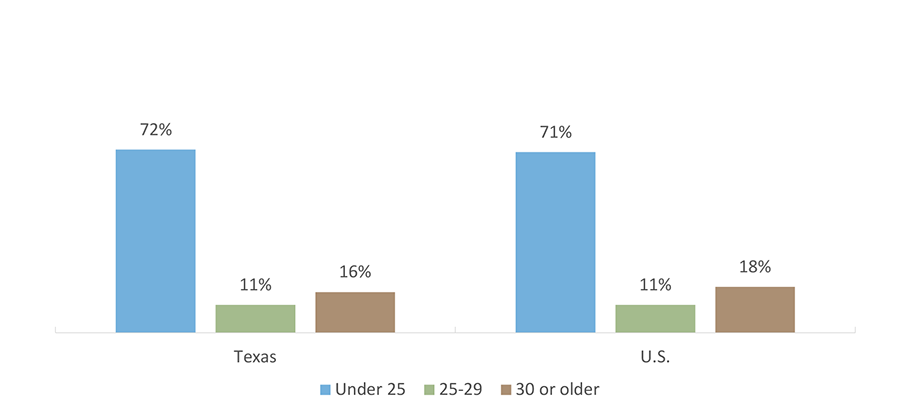
Age of Undergraduates in Texas by School Sector (Fall 2015)
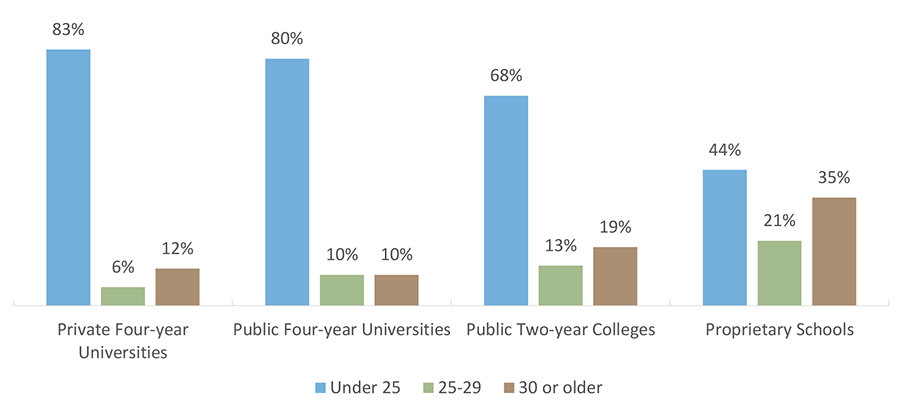
Of all Texas undergraduates in fall 2015, 72 percent were under age 25, 11 percent were between age 25 and 29, and 16 percent were age 30 or older. In the U.S. as a whole, older undergraduates are only marginally less common, with 71 percent of fall 2015 undergraduates under the age of 25, 11 percent between age 25 and 29, and 18 percent age 30 or older.
About four in five undergraduates at public four-year universities and eight out of ten at private four-year universities are under the age of 25. At public two-year colleges, 68 percent of students are under age 25. Proprietary schools and public two-year colleges have higher percentages of older undergraduates. About 35 percent of undergraduates at proprietary schools and 19 percent of undergraduates at public two-year colleges are age 30 or older.
Sources: U.S. Department of Education, National Center for Education Statistics, Integrated Postsecondary Education Data System (IPEDS) 2016 (http://nces.ed.gov/ipeds/).
U.S. Postsecondary Students by Income as Percent of Poverty Line, 2000-2016
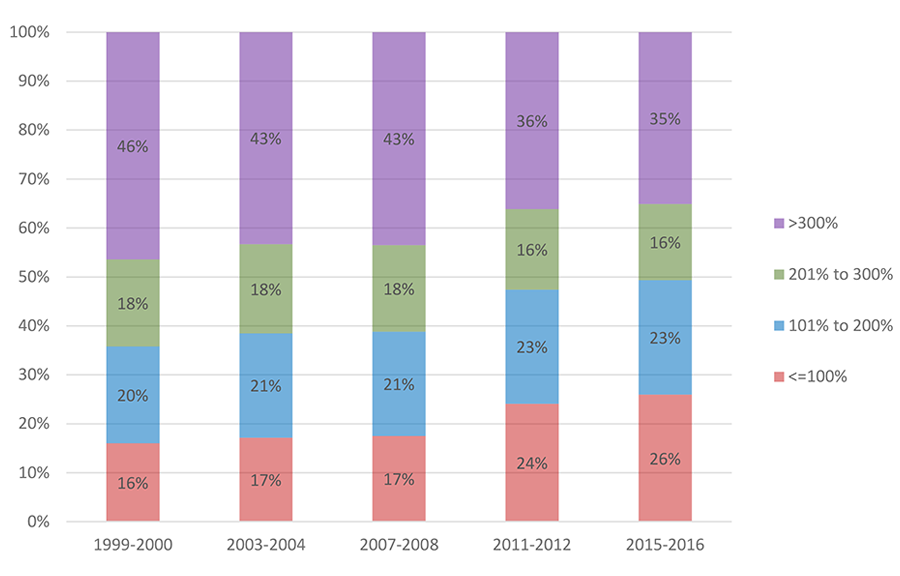
In the 1999-2000 academic year (AY), almost half of college students had a family income of at least 300 percent of the poverty level in that timeframe. By AY 2015-2016, only about a third of college students were in that income category, while those at or below the poverty level increased from 16 percent in AY 1999-2000 to 26 percent in AY 2015-2016.
Federal U.S. Department of Health and Human Services poverty guidelines were used along with family size and income to determine the percent. For dependent students, the family size and income of their parents are used. For independent students, the family size and income of that student is used. Students in Alaska and Hawaii had their rates calculated using different, state-specific, poverty guidelines.
Sources: U.S. Department of Education, National Postsecondary Student Aid Study (NPSAS) (http://www.nces.ed.gov/das), survey years 2000, 2004, 2008, 2012, and 2016.
Percentage of U.S. Students Who Ever Took Developmental Education Courses, by Sector (AY 2015-2016)
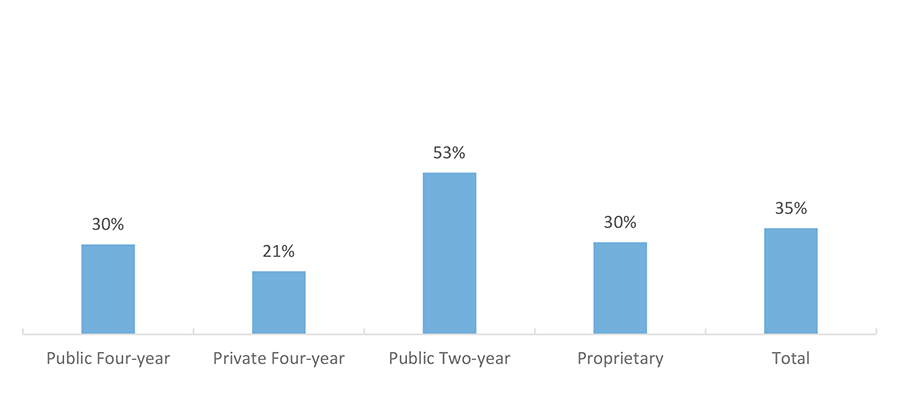
Percentage of U.S. Students Who Ever Took Developmental Education Courses, by Attendance Intensity (AY 2015-2016)
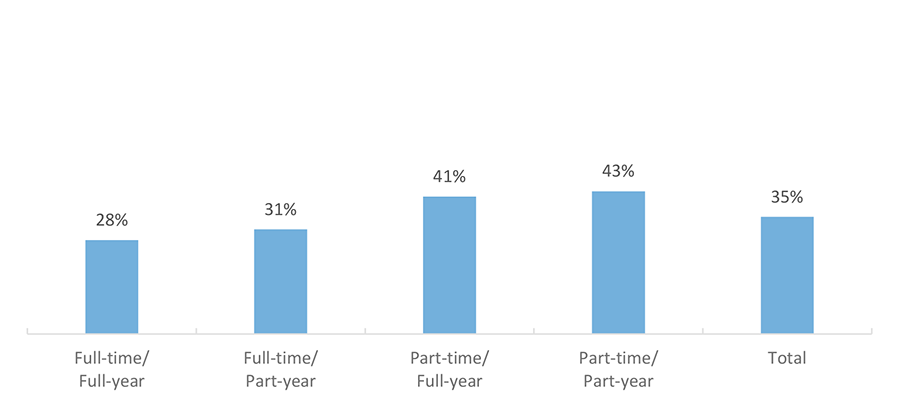
About a third of all undergraduates in the U.S. who graduated in academic year (AY) 2015-2016 had taken at least one developmental education course while in college. This varied somewhat by sector, with about 21 percent of private four-year undergraduates and more than half of students at public two-year institutions having been through developmental education.
Students who attended full time all through their postsecondary education were the least likely to take developmental education courses compared to students with other attendance intensity patterns. As the attendance pattern shifts away from full time attendance, students are more likely to have taken at least one developmental education course in college.
Students who take developmental education courses are less likely to graduate than their peers. In the Texas public four-year sector, students who did not take developmental education courses had double the graduate rate of their developmental education peers six years after entering higher education. The same pattern is seen in the public two-year sector with the non-developmental education students graduating at nearly double the rate of developmental education students three years after entering college.
Sources: U.S. Department of Education, National Postsecondary Student Aid Study 2016 (NPSAS) (http://www.nces.ed.gov/das); Graduation Rate: Texas Higher Education Coordinating Board (THECB), Graduation and Persistence of Developmental Education Students (http://www.txhighereddata.org/index.cfm?objectId=200A40A0-E156-11E8-BB650050560100A9).
Percentage of Top 10 Percent Admits Among First-Time Texas Public Four-Year University Students (Fall 2017)
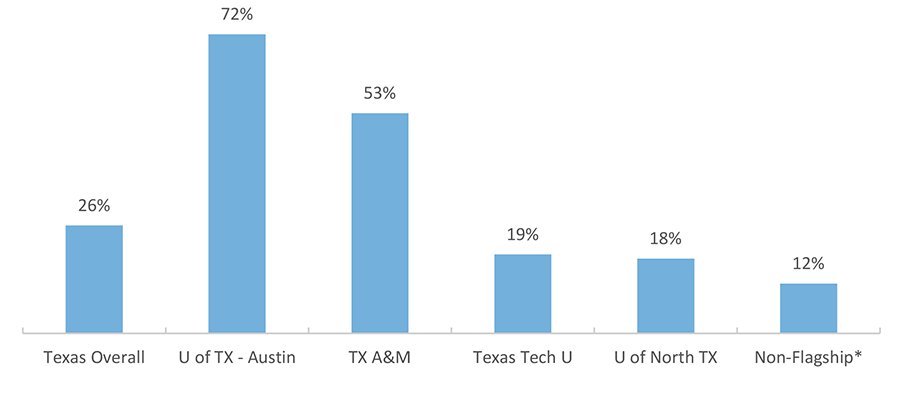
While the majority of first-time students at two of Texas’ public flagship universities – the University of Texas at Austin and Texas A&M University – are drawn from the top ten percent of Texas high school classes, the far majority of students at Texas public universities are not. Top ten percent graduates account for about 26 percent of all first-time Texas public university students and only about 12 percent* of first-time students at the non-flagship universities, which account for about 71 percent of all Texas public university undergraduates.
As of fall 2017, 26 percent of first-time public university students were top ten percent admits. Three out of 33** non-flagship public universities exceeded this proportion: the University of Houston at 30 percent, University of Texas at Dallas at 30 percent, and University of Texas at Arlington at 27 percent. Two others exceeded 20 percent: the University of Texas at the Permian Basin (22%) and Texas A&M International University (22%).
Eleven public universities had first-time classes whose share of top ten percent enrollment was less than ten percent.
*Estimate based on applying the percentage of top ten percent graduates among first-time students to the number of enrolled freshmen-level students.
**This is the number of non-flagship public universities for which the THECB had data on the percentage of top 10 percent enrollments. There are 37 Texas public universities in total.
Source: Texas Higher Education Coordinating Board (THECB) 2018 Higher Education Almanac Institutional Comparison Sheets ((http://www.thecb.state.tx.us/index.cfm?objectid=629F37F0-861F-11E8-AE230050560100A9).
Percent of U.S. Undergraduate Enrollment that is First Generation,*
Nationally by Year
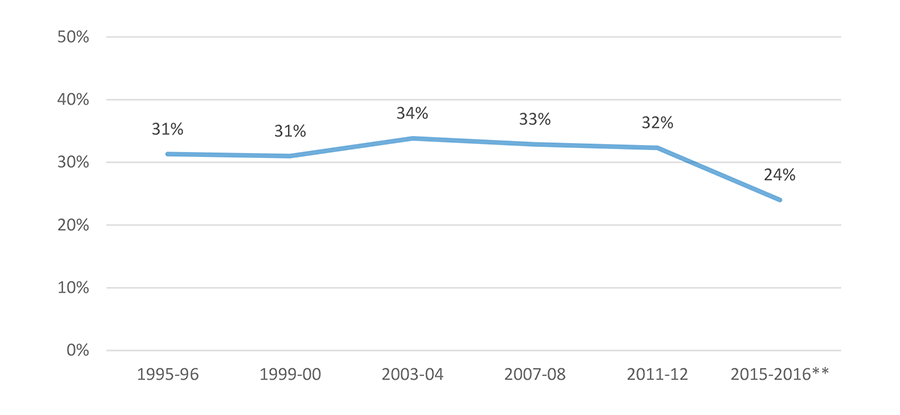
The proportion of U.S. students who are the first in their families to attend college has declined sharply since 2011-12. While first generation students are highly represented in all school sectors, the largest concentration appear at proprietary schools and public two-year colleges.
Percent of U.S. Undergraduate Enrollment that is First Generation,*
Nationally by School Type for Academic Year 2015-16
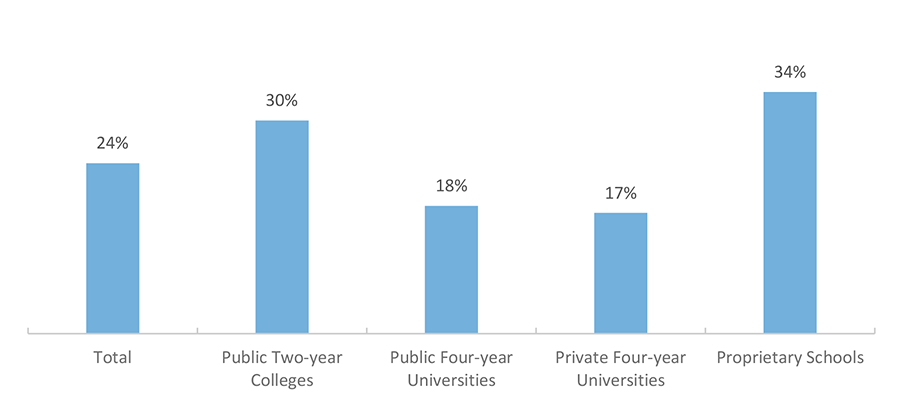
* First generation for this purpose is defined as students who have parents with the highest level of education attained by either one as high school or below. This does not include those with parents who attended some college or those who are unsure of their parents’ educational levels.
**A change was made for the 2015-2016 survey that expanded the definition of parent to include step-parents or other adult guardians.
